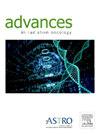Examining Barriers to Practice in Genitourinary and Gynecologic Radiation Oncology: Results from 2 Nationwide Surveys
IF 2.7
Q3 ONCOLOGY
引用次数: 0
Abstract
Purpose
Gender diversity in academic radiation oncology (RO) has become a topic of interest in recent years, with studies showing that practicing female academic radiation oncologists (AROs) are outnumbered by male colleagues at a rate of approximately 3:1. Gender differences are also observed in subspecialties whose patient populations are overwhelmingly of a single gender, such as genitourinary (GU) and gynecologic (GYN) RO. We aimed to investigate whether challenges exist for academic RO physicians who primarily treat patients of another gender, and, if so, what barriers they face in practice.
Methods and Materials
We conducted 2 national surveys of female GU academic RO physicians and male GYN academic RO physicians working at Accreditation Council for Graduate Medical Education-accredited academic centers. Survey questions focused on career path, challenges faced, and barriers to practicing GU or GYN oncology.
Results
A total of 13/42 (30.2%) GU survey recipients responded as treating GU oncology and 31/77 (40.3%) GYN survey recipients responded as treating GYN oncology. Of these respondents, 9 GU and 3 GYN physicians reported facing challenges as an academic RO faculty member because of their gender identity, and 5 GU and 4 GYN physicians reported that their subspecialty specifically presented challenges. Neither group commonly reported difficulties developing trust and rapport with patients. In the GU academic RO group, reports of challenging relationships with other professional colleagues were common. Difficulties finding or serving as a mentor were also common in both groups.
Conclusions
Female GU AROs and male GYN AROs may face unique challenges. Identifying and understanding these challenges directly from practicing physicians are important steps in improving professional success, career satisfaction, and clinical care quality.
检查泌尿生殖和妇科放射肿瘤学实践的障碍:来自2个全国性调查的结果
目的:近年来,学术放射肿瘤学(RO)的性别多样性已成为人们关注的话题,研究表明,在职的女性学术放射肿瘤学家(AROs)与男性同事的比例约为3:1。性别差异也被观察到在亚专科,其患者群体绝大多数是单一性别,如泌尿生殖(GU)和妇科(GYN) RO。我们的目的是调查主要治疗其他性别患者的学术RO医生是否存在挑战,如果存在,他们在实践中面临哪些障碍。方法与材料我们对在研究生医学教育认证委员会认可的学术中心工作的女性GU学术RO医师和男性GYN学术RO医师进行了2次全国调查。调查问题集中在职业道路、面临的挑战以及从事妇科肿瘤学的障碍。结果13/42(30.2%)的GU调查受者应答为治疗GU肿瘤,31/77(40.3%)的GYN调查受者应答为治疗GYN肿瘤。在这些受访者中,9名GU医生和3名GYN医生报告说,作为一名学术RO教员,由于他们的性别认同而面临挑战,5名GU医生和4名GYN医生报告说,他们的亚专业特别面临挑战。两组医生都没有普遍报告在与病人建立信任和融洽关系方面存在困难。在GU的学术RO组中,与其他专业同事的关系具有挑战性的报告很常见。在这两个群体中,寻找或担任导师的困难也很常见。结论女性GU AROs和男性GYN AROs可能面临独特的挑战。直接从执业医师那里识别和理解这些挑战是提高专业成功、职业满意度和临床护理质量的重要步骤。
本文章由计算机程序翻译,如有差异,请以英文原文为准。
求助全文
约1分钟内获得全文
求助全文
来源期刊

Advances in Radiation Oncology
Medicine-Radiology, Nuclear Medicine and Imaging
CiteScore
4.60
自引率
4.30%
发文量
208
审稿时长
98 days
期刊介绍:
The purpose of Advances is to provide information for clinicians who use radiation therapy by publishing: Clinical trial reports and reanalyses. Basic science original reports. Manuscripts examining health services research, comparative and cost effectiveness research, and systematic reviews. Case reports documenting unusual problems and solutions. High quality multi and single institutional series, as well as other novel retrospective hypothesis generating series. Timely critical reviews on important topics in radiation oncology, such as side effects. Articles reporting the natural history of disease and patterns of failure, particularly as they relate to treatment volume delineation. Articles on safety and quality in radiation therapy. Essays on clinical experience. Articles on practice transformation in radiation oncology, in particular: Aspects of health policy that may impact the future practice of radiation oncology. How information technology, such as data analytics and systems innovations, will change radiation oncology practice. Articles on imaging as they relate to radiation therapy treatment.
 求助内容:
求助内容: 应助结果提醒方式:
应助结果提醒方式:


